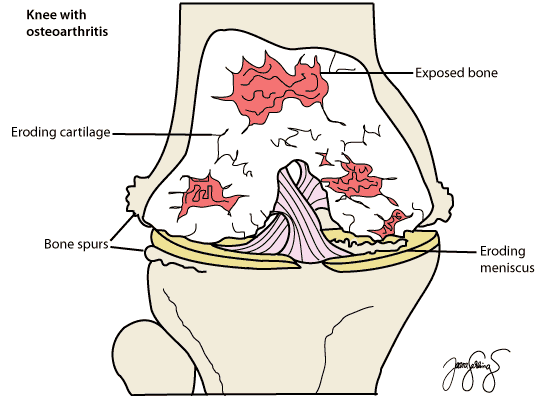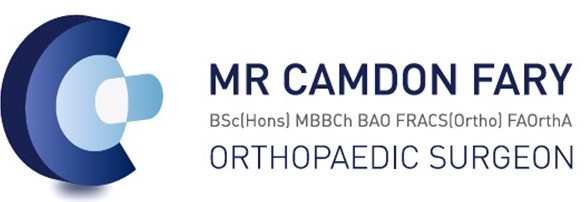What is a Knee arthroscopy?
Knee arthroscopy, also known as ‘key hole surgery’, is an operation which enables the surgeon to look inside the knee joint and perform surgery on it without making big cuts to expose the joint.
Knee arthroscopy is performed by making small cuts on either side of the knee through which a special camera is inserted into one side whilst specialised tools are inserted into the other side.
Knee arthroscopy can be used to treat a variety of knee problems and is one of the most common knee operations being performed.

-
Who is the operation for?
Knee arthroscopy can be effective for treating a variety of problems. Common problems treated using this technique include:
-
- Torn meniscus: A meniscus is a ring of cartilage in your knee that acts as a shock absorber. It can be torn, often during sporting activities, and cause symptoms of clicking or locking of the knee. A torn meniscus can be trimmed or stitched together during an arthroscopy

- Loose bodies: Small pieces of cartilage can break off from joint surfaces or meniscus. These cal float around in the knee and cause pain, locking or clicking. These loose bodies can be removed during an arthroscopy.
- Cartilage repair: Cartilage that lines the joint surfaces may become frayed and worn out. This can be trimmed during an arthroscopy. Unfortunately the worn out cartilage can’t be replaced.
- Investigation of unexplained knee pain: Occasionally knee pain will be persistent in spite of no problem being identified on X-ray or MRI scans. Sometimes the surgeon will decide to investigate the cause of the pain using an arthroscopic procedure.
- Removal of tumours or other tissue: An arthroscopy may be used to remove a small growth or tumour. Sometimes a growth in the lining of the joint (known as the synovium) may be removed during an arthroscopy. These conditions are vary rare and not a common cause for an arthroscopy.
- Infection: If you have a knee joint infection, an arthroscopy may be used to wash out the joint and ensure that the infection improves.
Does arthroscopy work for a worn out knee (also known as osteoarthritis)?
If you have advanced wear and tear of the knee joint, known as osteoarthritis, an arthroscope is probably not for you. The only surgery that will probably help is a knee replacement. If you have a worn out knee but also have a torn meniscus or a loose body, then an arthroscope may actually be very helpful.
-
-
Complications
The complication rate following knee arthroscopy is very low. However like all surgery, there are risks that need to be considered when deciding to have knee arthroscopy surgery.
Side effects
Side effects are symptoms that occur due to the surgery and are a normal part of the recovery from the operation. The main side effects of knee arthroscopy are:- A sore knee which may last for several weeks after the operation.
- Swelling of the knee which may last for several weeks.
Complications
Complications are problems that occur during or after the operation. Most people having knee arthroscopy surgery aren’t affected and complications are a rare event. There are some complications that may occur for any operation. These include:- A reaction to the anaesthetic
- Infection of the wound or joint
- Excessive blood loss
- A blood clot, usually in a vein of the leg (known as a deep vein thrombosis or DVT)
Specific complications of knee arthroscopy are very uncommon, but can include the following:
- Bleeding into the knee joint (haemarthrosis): Occasionally a blood vessel may be damaged during the arthroscopy leading to bleeding into the joint after the operation. This will result in swelling of the knee which may be stiff and painful. This is a rare complication, occurring in roughly 0.46% of cases.
- Chronic Regional Pain Syndrome: A rare complication is ongoing knee pain following knee arthroscopy. This occurs in less than 1% of people having the operation.
- Stiffness: Sometimes you may be left with stiffness of the knee joint following the operation. This is a rare complication, happening in only 0.11% of people having an arthroscopy.
- Accidental damage to structures inside the knee joint: Occasionally cartilage or ligaments of the knee joint may be damaged during an arthroscopy. This is a very rare complication.
-
Before the Operation
Preparing Your Skin
Your skin should not have any infections or irritations before surgery. If either is present, contact Mr Fary’s Staff on 9928 6161.
Medications
Mr Fary and his anaesthetist will advise you which medications you should stop or can continue taking before surgery.
Get some help from your friends and family
Although you will be able to walk soon after surgery, you will need some help for several days with such tasks as cooking, shopping, bathing, and laundry.
If you live alone, we can arrange for you to stay longer in hospital, depending on availability.
Please let our staff know, and we’ll do our best to accomodate for your needs.
Tip
Carry a list of your medications with you including the name, dosage and how often you take it.
-
During the Operation
Admission
Most people are admitted to hospital on the day of their surgery. For a knee arthroscopy you can usually go home on the day of your surgery but some people will need to stay overnight.
Anaesthesia
The anaesthetist will see you and decide the type of anaesthetic that’s best for you.
The different types of anaesthesia include:
- General Anaesthetic. This type of anaesthetic puts you asleep during the whole procedure and a machine controls your breathing. The vast majority of knee arthroscopies are performed under a general anaesthetic.
- Spinal Anaesthetic. An injection is placed into your back to numb your hip and legs. You will be awake during the procedure, however a sedative can be given to you to help you doze off.
- Nerve Blocks. This special injection is used to help with your pain after the operation and often used in conjunction with a general anaesthetic.
If you have any questions or concerns about your anaesthetist, we would encourage you to contact your anaesthetist before the operation, with the contact details that we have provided for you.
The Operation
Two small cuts are made in the front of the knee. The cuts are usually roughly 1cm long. The first cut is used to insert a special video camera into the knee. The other cut is used to insert instruments into the knee joint. Very occasionally a third cut will be made if necessary to insert other instruments.
Once the camera is inserted into the knee joint, the knee can be thoroughly examined. Special instruments are used to trim or repair cartilage tears, remove loose bodies or other tissue as required. During this time, there will be a flow of sterile water through the joint. Once the structures requiring attention have been addressed, the instruments are removed.
The wounds are usually closed with steristrips but sometimes 1 – 2 sutures are needed if the knee is particularly swollen after the operation. The whole operation usually takes 30 – 60 minutes to complete.
Recovery Room
After the operation, you will be resting in the recovery room, where specially trained recovery nurses will closely monitor you until after you wake up safely.
-
After the Operation
You will go home with some pain relief to help with the pain for the first few days. Try to keep the leg elevated in the first few days after the operation to help limit swelling.
In the first two weeks, the knee should be regularly iced to reduce swelling.
Try to bend your knee and keep your thigh muscles active in the first two weeks after an arthroscopy in order to avoid stiffness.
Gentle cycling is very helpful in reducing your swelling and increasing your recovery.
Wound care
Although the wounds are small, they still need to be carefully looked after. The dressing over the wound should remain in place for the 7 days.
If you only had steristrips placed, then you can remove your dressing yourself.
If you had stitches, then you will need them removed by a trained health professional such as a doctor or nurse.
-
Recovery & Rehabilitation
Rehabilitation
The rehabilitation program varies depending on what was operated on during the arthroscopy.
Your physiotherapist will give you exercises to help to improve the flexibility and strength of the knee. It is important to follow the advise of the physiotherapist and make sure that you complete the recommended exercises in order to get the best outcome from the operation.
Back to work / sport
If you work in an office environment your should be able to return to work within a week of the operation. Unless you have had your ACL repaired during an arthroscopy, you should be able to return to most physical activities 6 – 8 weeks after the operation. An ACL reconstruction takes longer to recover from.
If you have a heavy manual job, or participate in high impact sports, you may need to wait longer before returning to these activities. Most people are able to return to manual duties after 4 -6 weeks.
Driving
Most people are able to drive a few days after the operation. The length of time it will take to get back to driving depends on which leg was operated on, the problem that was operated on and how much pain you have after the operation.
-
FAQ’s
What are the alternative treatments to having a Knee arthroscopy?
Not everyone with knee pain needs to have a knee arthroscopy.
Meniscal tears that are catching and locking inside are a very good reason to have a knee arthroscopy, as they rarely get better with conservative treatment.
However, meniscal tears that cause little pain and don’t lock or click, can be treated with exercise, strengthening and physiotherapy. With the occasional use of pain killers and anti-inflammatories.
Knee arthroscopy is not useful for osteoarthritis. Even though it sounds reasonable to perform a knee arthroscopy to “clean out the knee”, studies have shown that it does not make a difference in the long term.

You must be logged in to post a comment.